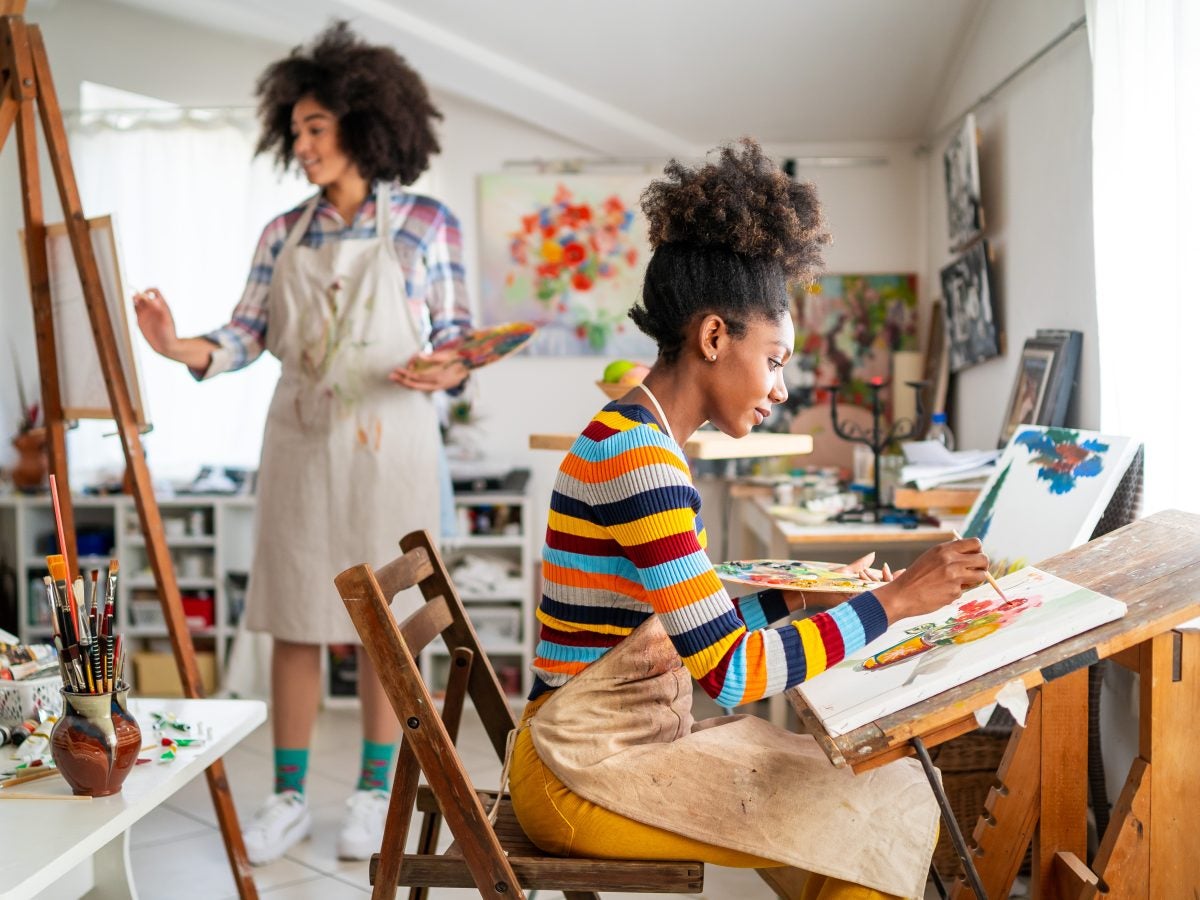
In this Keeping It Z column piece, writer Daria Harper rounds up Black women painters who should be on everyone’s radar.
Though it’s taken time for the industry to begin acknowledging, Black women artists have always been at the forefront of prominent visual art movements and sparking crucial dialogue with their work. Following in the footsteps of revolutionary artists like Alma Thomas, Gwendolyn Knight, and Faith Ringgold, a new generation of emerging Black women artists are reshaping the future of both abstract and figurative painting.
Keep scrolling to learn more about the artists we can’t get enough of.
Jamilla Okubo
Interdisciplinary artist Jamilla Okubo is celebrated for her striking figurative paintings that explore the nuances of her identity as an American, Kenyan, and Trinidadian woman. Incorporating vivid textiles and designs, Okubo creates vibrantly-colored works that celebrate the Black body, especially women’s figures, in connection with movement and expression. She produces her own patterns inspired by kanga cloth, a colorful fabric that conveys messages ranging from Swahili proverbs to African pop culture.
Jewel Ham
Jewel Ham creates sultry paintings of Black women, while paying close attention to texture, color, and skin. Influenced by her love of music and women MCs, Ham depicts women who exude self-confidence and hold a fierce gaze. One recent work titled Sitting Right with My Spirit (2021) deals with the importance of intuition and ancestry, and refers to the phrase often used when we try to ignore such deep-rooted feelings. Ham recently joined the roster at the budding Cierra Britton Gallery, New York City’s first art gallery dedicated to solely representing women of color artists.
Uruba Slaughter
Uruba Slaughter’s captivating abstract paintings remind viewers of the important role Black artists play in the field of abstraction. Slaughter’s works are characterized by rich colors and textures which resemble natural elements like stone. Her use of the rough surface is informed by her experience overcoming a serious health issue, thanks to her artistic practice. This element serves as a metaphor for several contrasts explored throughout Slaughter’s work, such as life/death and pain/beauty.
Ariel Dannielle
Working primarily in self-portraiture, Atlanta-based artist Ariel Dannielle paints vibrant, joy-filled scenes inspired by moments from her everyday life. Whether posing with friends for a flick, standing in the mirror applying makeup, or capturing a selfie with her husband, her detailed self-portraits provide an important point of relatability for many young Black women. Dannielle aims to provide new narratives for Black womanhood through her deeply personal depictions of Black women experiencing leisure, joy, and simply existing.
Genesis Tramaine
Genesis Tramaine has received critical acclaim for her intricate portraits. Oscillating between abstraction and figuration, Tramaine’s practice is completely fueled by her faith, particularly her experience as a queer Christian artist. A self-described devotional painter, she depicts deconstructed faces that represent biblical figures and garner stylistic inspiration from 1980s graffiti. Tramaine’s artworks often relate back to her upbringing and honoring the women that raised her.
Jadé Fadojutimi
Jadé Fadojutimi weaves webs of color and explosive lines on her canvases, examining identity and environment. Fadojutimi’s paintings feature prominent brushstrokes that sometimes form faint shapes. They also reflect personal narratives and memories that shape the artist’s identity.
Her recent work, Ob-sess(h)-ion (2020), shows thick etches of pink, blue, and lavender paint layered into what loosely resembles a dreamy floral pattern. Like much of Fadojutimi’s work, the painting possesses an essence of fluidity.
Kadine Lindsay
Kadine Lindsay explores the limitless beauty of the Black fantasy genre through her paintings. Lindsay recently explained her work to Good Black Art, saying, “I want to make a sexy, Black Beetlejuice.”
Her work is inspired by visuals from her Jamaican heritage and childhood, as well as pop culture references from the late 90s and early 2000s. Lindsay paints subjects that are almost cartoon-like, characterized by green and lilac-hued skin, and swirling forms. With electric eyes and finger-waved hair, the figures are sexy, yet simultaneously eerie; drawing viewers into the world on the canvas.
